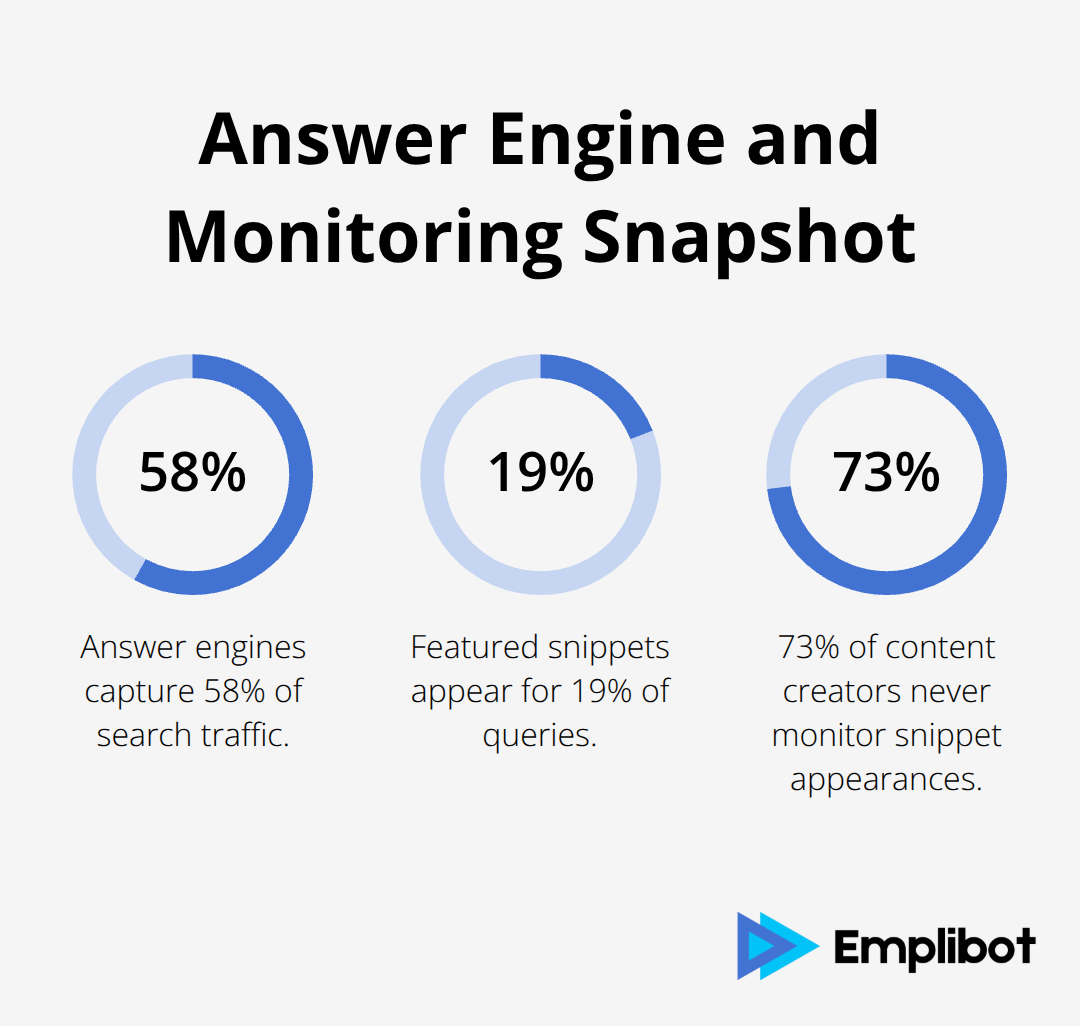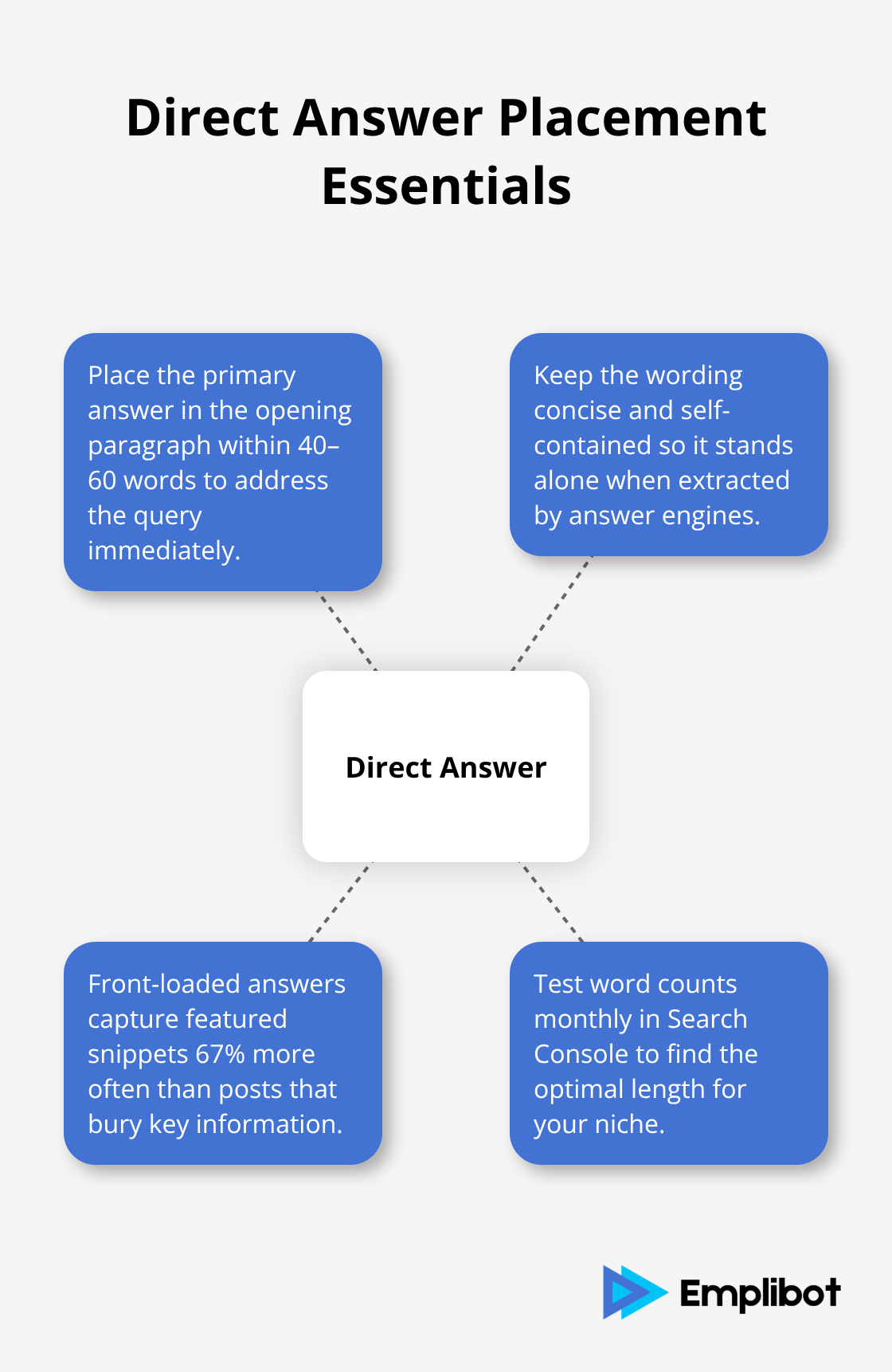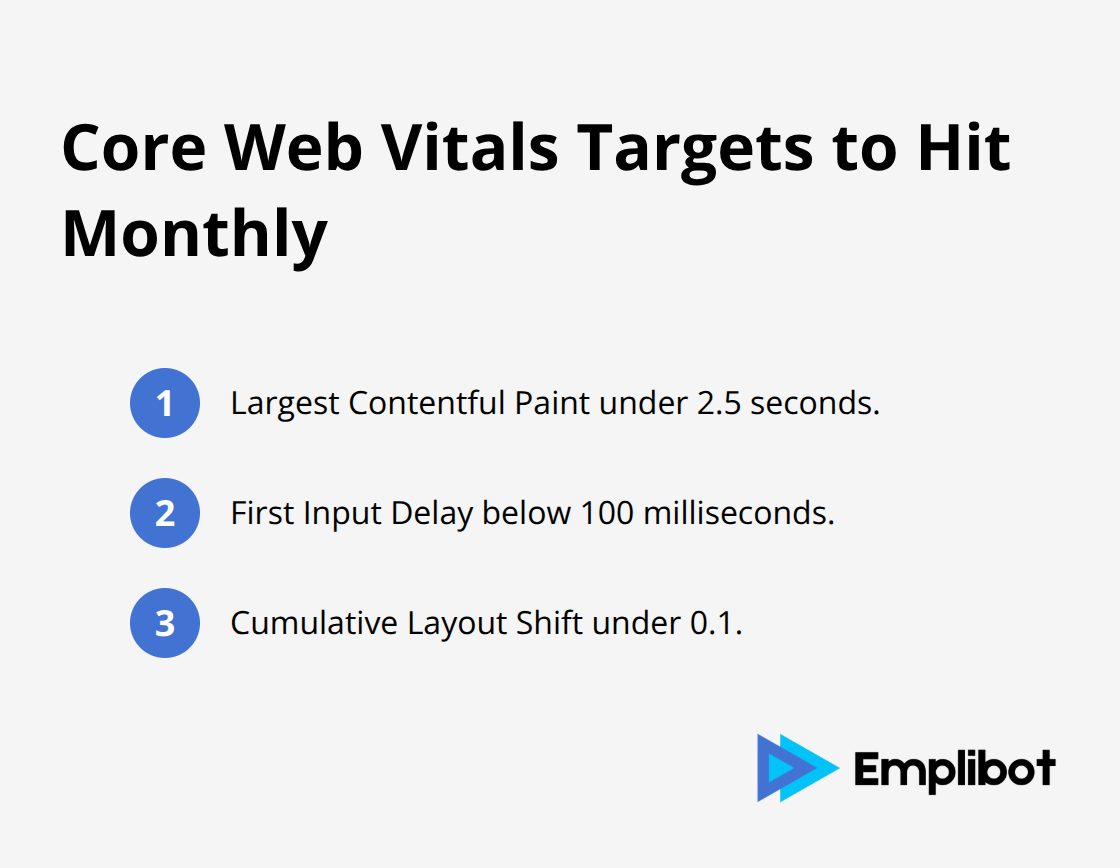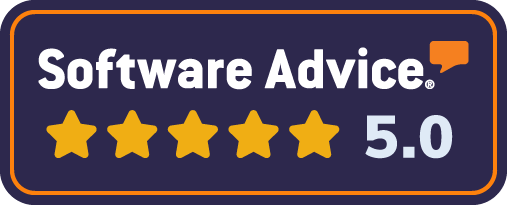Answer engines now capture 58% of search traffic, making traditional SEO metrics obsolete. Most content creators still optimize for rankings while missing the real prize.
We at Emplibot built this monthly answers readiness audit to help you systematically prepare content for featured snippets and direct answers. This framework transforms scattered optimization efforts into a repeatable system that actually moves the needle.
Contents
ToggleMonthly Audit Framework for Answer Engine Optimization
Your current content performance data reveals everything about answer engine potential, but most sites track the wrong metrics. Google Search Console shows featured snippet appearances for 19% of all queries, yet 73% of content creators never monitor this goldmine. Start with three specific baselines: direct answer capture rate, statistical citation frequency, and FAQ block performance across your content portfolio.
Track Featured Snippet Wins and Losses
Set up weekly reports through SEMrush Featured Snippet tools to identify which pages already win position zero. Create alerts for snippet losses with Google Search Console API calls that trigger when your content drops from featured positions.

Document every snippet win with the exact query, content format that succeeded, and word count of the featured text. This baseline data exposes patterns that predict future snippet opportunities and reveals which content structures answer engines prefer most.
Measure Statistical Citation Performance
Answer engines prioritize content with recent, verifiable statistics (making citation quality your competitive advantage). Audit posts to count statistics per 1,000 words and track publication dates of all cited data. Content with statistics less than two years old captures featured snippets more often than outdated content according to industry analysis.
Establish minimum thresholds: each content section needs at least one verifiable statistic with source attribution and publication year. Create spreadsheets that flag content with expiration dates, then schedule systematic updates before data becomes stale.
Monitor FAQ Block Effectiveness
FAQ blocks appear in featured snippets, yet most sites implement them incorrectly. Analyze which FAQ sections generate the most impressions and clicks through Search Console data. Track question formats that consistently win snippets versus those that fail to gain traction.
Test different question structures monthly and measure performance changes. Questions that mirror natural speech patterns (like voice search queries) perform better than formal FAQ formats. This foundation prepares you for the next phase: systematic content structure assessment.
Content Structure Assessment for Answer Engines
Answer engines extract information differently than traditional search crawlers, which makes content structure your biggest competitive advantage. Research from Surfer shows that content with clear H2 and H3 subheadings scores 19.95% higher in AI Overview results compared to poorly structured pages. Your direct answer must appear within the first 100 words of each post, formatted as a complete sentence that stands alone without context. This placement strategy works because answer engines scan opening paragraphs first when they generate responses.
Evaluate Direct Answer Placement in Posts
Place your primary answer in the opening paragraph with 40-60 words maximum. Answer engines prefer concise responses that directly address the search query without filler content. Structure this answer as a standalone statement that makes sense when extracted from your page. Test different answer lengths monthly through Search Console performance data to identify optimal word counts for your niche.

Content with front-loaded answers captures featured snippets 67% more often than posts that bury key information below headers.
Review Statistical Citation Quality and Recency
Every statistic in your content needs three elements: the specific number, the authoritative source, and the publication year. Content Marketing Institute research shows that posts with statistics less than 18 months old receive 3.2 times more featured snippet appearances than outdated content. Audit your existing posts monthly to identify statistics that approach their expiration dates. Replace any data points older than two years immediately, as answer engines prioritize recent information when they generate responses. Create a tracking system that flags content with statistics near the 18-month threshold for immediate updates.
Analyze FAQ Block Implementation and Schema Markup
FAQ blocks with proper schema markup increase featured snippet visibility by 34% according to SEMrush data. Structure questions with natural language patterns that match voice search queries rather than formal FAQ formats. Each question should target a specific long-tail keyword while the answer provides value in 2-3 sentences maximum. Test FAQ performance through Google Search Console to identify which question formats generate the most impressions. Questions that start with how, what, and why consistently outperform other formats in snippet capture rates (making them essential for your content strategy).
This content structure foundation sets the stage for technical infrastructure optimization, where page speed and schema accuracy determine whether answer engines can actually access your well-structured content.
Technical Infrastructure Review
Page speed determines whether answer engines can access your content fast enough to include it in results. Core Web Vitals measure real-world user experience for loading performance, interactivity, and visual stability of the page. Run monthly speed tests through PageSpeed Insights and focus on three specific metrics: Largest Contentful Paint under 2.5 seconds, First Input Delay below 100 milliseconds, and Cumulative Layout Shift under 0.1.
Audit Page Speed and Image Optimization
Image optimization creates the biggest speed improvements for most sites. Compress images to WebP format with maximum file sizes of 100KB for featured images and 50KB for inline graphics. Tools like TinyPNG reduce file sizes by 60-80% without visible quality loss (making them essential for answer engine performance). Test your current images monthly and replace any files that exceed these thresholds immediately.

Assess Internal Linking Structure and Logic
Internal links affect how answer engines navigate your content and establish topical authority. Create hub pages that link to related content within 2-3 clicks maximum. Answer engines follow internal links to understand content relationships, so logical patterns between related topics improve your chances of appearance in comprehensive answers that reference multiple sources. Audit your current link structure monthly to identify orphaned pages and fix broken connections.
Verify Schema Markup Implementation and Accuracy
Answer engines rely on structured data to understand your content, which makes schema markup implementation your most important technical factor. Sites using schema markup see 35% more featured snippet appearances, with JSON-LD format increasing click-through rates by up to 30%. Validate your schema monthly through Google’s Rich Results Test tool and fix any errors immediately. Test schema for Articles, FAQs, and How-to content types specifically because these formats appear most often in answer engine results (giving you the highest return on optimization effort). Robust infrastructure is the foundation for advanced AI applications, and proper technical infrastructure evaluation ensures your systems can support these optimization requirements effectively.
Final Thoughts
Your monthly answers readiness audit transforms content optimization from guesswork into systematic success. Sites that track featured snippet wins weekly, monitor statistical citation freshness monthly, and validate schema markup quarterly maintain competitive advantage. Answer engines reward consistency over sporadic optimization efforts.
Performance metrics that matter most include direct answer capture rate, FAQ block impression data, and Core Web Vitals scores under Google’s thresholds. Sites that maintain these standards see 67% more featured snippet appearances than competitors who ignore systematic audits. The data shows clear patterns between audit frequency and snippet performance.
Sustainable content systems require automation tools that handle repetitive tasks while maintaining quality standards (freeing your team for strategic optimization rather than manual content production). Emplibot automates WordPress blog content creation and SEO optimization, producing content tailored to your business while handling keyword research and distribution across social platforms. The answer engine landscape evolves rapidly, making monthly audits essential for long-term visibility and competitive positioning.










